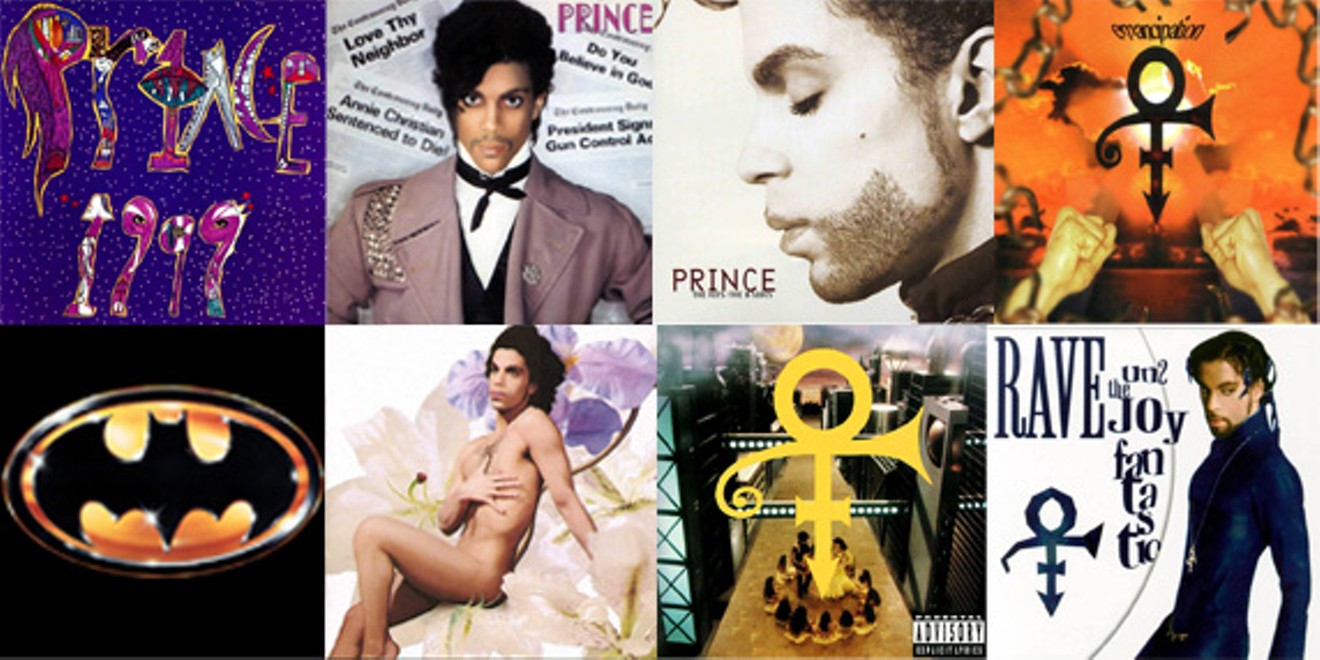Support Us
Houston's independent source of
local news and culture
account
- Welcome,
Insider - Login
- My Account
- My Newsletters
- Contribute
- Contact Us
- Sign out
Dig If You Will a New Book That Examines Prince's Life Through His Work
Bob Ruggiero April 11, 2017 4:00AM

Just some of the more than 40+ albums Prince released in his career. Thousands of hours of additional music are thought to be stored in his Paisley Park vault.
Photo montage
[
{
"name": "Related Stories / Support Us Combo",
"component": "11591218",
"insertPoint": "4",
"requiredCountToDisplay": "4"
},{
"name": "Air - Billboard - Inline Content",
"component": "11591214",
"insertPoint": "2/3",
"requiredCountToDisplay": "7"
},{
"name": "R1 - Beta - Mobile Only",
"component": "12287027",
"insertPoint": "8",
"requiredCountToDisplay": "8"
},{
"name": "Air - MediumRectangle - Inline Content - Mobile Display Size 2",
"component": "11591215",
"insertPoint": "12",
"requiredCountToDisplay": "12"
},{
"name": "Air - MediumRectangle - Inline Content - Mobile Display Size 2",
"component": "11591215",
"insertPoint": "4th",
"startingPoint": "16",
"requiredCountToDisplay": "12"
}
,{
"name": "RevContent - In Article",
"component": "12527128",
"insertPoint": "3/5",
"requiredCountToDisplay": "5"
}
]
Dig If You Will the Picture: Funk, Sex, God & the Genius in the Music of Prince
By Ben Greenman
Henry Holt, 304 pp., $28
As we approach the first anniversary of the shocking and abrupt death of Prince on April 21, his demise remains the most affecting of the many musician passings of 2016. Ever since, the life and music of the Purple One have been celebrated and dissected with several new books (including one coming out by former wife Mayte), reissues, and just a smidgen of voluminous unreleased tracks in the Paisley Park vault. He’s even been the subject of a couple of adult coloring books, which seems highly appropriate.
But here, obsessive Prince fan Ben Greenman – who has co-written memoirs with George Clinton, Questlove and Brian Wilson – takes a different approach. While Dig If You Will the Picture has biographical aspects of Prince’s life, it’s not a biography. Instead, it looks at major themes in Prince's work, including sex, death, religion, musical influences and his relations to others – folding all of the above into one big mix sprinkled with critical material and personal essays.
But most interesting are chapters on two aspects of Prince’s career where, for once, he was the outsider. That includes his checkered record of both embracing and rejecting hip-hop and rap in his own work. The other is his often tortured relationships with fans and the Internet. The latter he seemed to want to both police and control, first as a way to stop “unauthorized” use of his music, and as a venue to release new music via several complicated and failed launches and subscription services. Which sometimes did not deliver as promised.
Lawsuits that Prince’s lawyers (likely at his behest) filed against fanzine editors come off as peevish. Worse was the suit against a young mother who posted a 29-second YouTube clip of her baby dancing while “Let’s Go Crazy” plays in the background. It’s more shocking to note that the legal conflict has lasted more than a decade, outliving even its aggrieved party.
While a fan, Greenman is not hagiographic in his commentary on the music that Prince did release, some 40+ albums and 100+ singles in his lifetime. That doesn’t even account for all the music he made available (even if fans had to play detective to find it). Many have noted this is attributable to Prince’s insane levels of creativity and work ethic, but Greenman argues he could have utilized some self-editing.
“Prince suffered from recurring self-indulgence. It’s not an uncommon problem among geniuses, especially ones so driven to demonstrate their genius,” the author writes. “Prince, always pushing himself forward, could stumble. Sometimes because he had strange ideas about [himself, his music or the music of others]. Sometimes it happened as the result of distraction or inertia or arrogance. But it happened. If consistency is the hobgoblin of little minds, his mind was huge.”
Houston is mentioned as the home of one of Prince’s many female protégés whose careers he both molded and attempted to launch, Tamar Davis. Davis was earlier in her life a member of an H-Town all-female rap and soul group called Girls Tyme, which featured a couple of other girls, named Kelly Rowland and Beyoncé Knowles. After Davis left, the collective would morph into Destiny’s Child.
In addition to the funk, sex and God topics of Prince’s music in the book’s title, Greenman also explores how Prince’s family, movie stardom, live performances, relationship to Minneapolis, race and gender politics all touched his work. His book is deep without being intimidating and detailed without making the reader cross-eyed.
Interestingly, the book’s greatest weakness is also a huge strength. Much of Greenman’s text eschews discussing Prince’s 19 Top 10 hits in detail in favor of more obscure tracks and albums known only to deeper fans (Lovesexy, Crystal Ball, Emancipation, The Black Album). But it does what any good music journalism should do: Make you want to visit — or revisit — the music.
KEEP THE HOUSTON PRESS FREE...
Since we started the Houston Press, it has been defined as the free, independent voice of Houston, and we'd like to keep it that way. With local media under siege, it's more important than ever for us to rally support behind funding our local journalism. You can help by participating in our "I Support" program, allowing us to keep offering readers access to our incisive coverage of local news, food and culture with no paywalls.
Bob Ruggiero has been writing about music, books, visual arts and entertainment for the Houston Press since 1997, with an emphasis on classic rock. He used to have an incredible and luxurious mullet in college as well. He is the author of the band biography Slippin’ Out of Darkness: The Story of WAR.
Contact:
Bob Ruggiero
Trending Music
- Houston Concert Watch 4/24: Rolling Stones, Bad Bunny and More
- How Much Longer Can Classic Rock Rule the Roost?
- Top 10 Butt-Rock Bands of All Time
-
Sponsored Content From: [%sponsoredBy%]
[%title%]

Don't Miss Out
SIGN UP for the latest
Music
news, free stuff and more!
Become a member to support the independent voice of Houston
and help keep the future of the Houston Press FREE
Use of this website constitutes acceptance of our
terms of use,
our cookies policy, and our
privacy policy
The Houston Press may earn a portion of sales from products & services purchased through links on our site from our
affiliate partners.
©2024
Houston Press, LP. All rights reserved.






